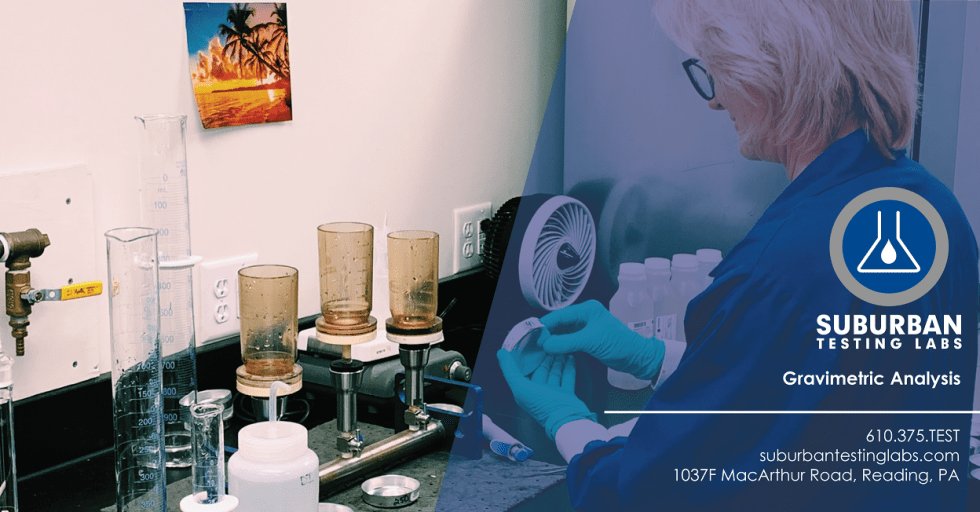Gravimetric Analysis

We have a lot of state-of-the art equipment in complex areas of our laboratory, but some parts of the environmental laboratory that rarely get talked about are in fact those that have the highest sample volumes and are critical to environmental decision making. One example of that is our Gravimetric Laboratory.
Over the past 12 months we’ve performed over 43,400 tests in our Gravimetric Lab, which is part of our Inorganic Chemistry Department. Tests analyzed here include Total Suspended Solids, Total Dissolved Solids, and Total Solids. What type of clients typically perform these tests, and what’s the difference between them? We wanted to shed some light on this very busy and very important area of our laboratory.
Common Client Types
The most common client type performing solids analysis is a wastewater treatment plant requesting Total Suspended Solids. These tests are required by the Department of Environmental Protection to ensure that plants discharging into our natural bodies of water are not exceeding limits on solid materials which could be harmful to aquatic life. High levels of suspended solids will decrease Dissolved Oxygen (DO) levels and could increase water temperatures by absorbing more heat from solar radiation.
Another common purpose for performing solids analysis is to support Environmental Site Assessments, where a client is trying to determine potential or existing environmental contamination liabilities of a property. Typically, Environmental Engineers and Consultants are working to examine if there is soil, ground water or surface water contamination, and will collect samples for various contaminants, including the determination of percent solids or moisture content of the samples.
The Differences
Total Suspended Solids (TSS)
TSS is the measurement of the particles that are floating or suspended in the water sample. We trap suspended particles with a pre-weighed filter using a filtration apparatus. Filters are dried to remove excess moisture, then are weighed to determine the particulates present in the water sample. Samples are typically taken at the Effluent (point after treatment) but are often also collected at the Influent (prior to treatment) as well.
TSS is listed as a “Conventional Pollutant” in the Clean Water Act, which means that it is amenable to treatment by a wastewater treatment plant. Other Conventional Pollutants include: BOD, Fecal Coliform, Oil & Grease, and pH.
Total Dissolved Solids (TDS)
TDS measures the combined total of organic and inorganic substances dissolved in the water sample. Although TDS are not considered a primary or conventional pollutant, it is commonly composed of calcium, phosphorous, nitrates, and other dissolved minerals. Clients may test for specific contaminants that may be dissolved in the water separately to determine the concentration of these constituents. Analysis procedures require filtration of the sample to remove any suspended solids. The filtrate of the sample is collected in a vessel, dried to remove moisture, then weighed to determine the total dissolved substance of the sample.
Total Solids or Percent Solids
Total Solids in waters is the total of all the solids in a sample. They include TSS, TDS, and Volatile components. In water, total solids will affect water clarity. Higher solids decrease the passage of light through water, slowing plant growth. The results are expressed in mg/L.
In soil, the solids content is the quantity of solid materials the soil contains separate from the moisture content. In addition to water and soil, total solids are also analyzed on biosolids, sludge and various solid materials for hazardous waste determination. This measurement is reported as a percentage when performed on solid matrices.
Analysis procedures include measuring the weight of the sample before and after a drying process is completed, designed to remove any moisture content from the sample.
Total Solids analysis is often needed to calculate other results that are obtained in the laboratory by other analysis methods.
Analysis
Our team of analysts work nearly around the clock processing samples from multiple states in the mid-Atlantic region. Our goal is to get our clients data fast, and so it takes a lot of coordination, communication, and collaboration from our team to make that happen.
While speed is important, high quality, defensible data always comes first. After our analysts prepare, analyze, and enter results for these samples, our team of Quality Specialists validate the results and quality control associated with each batch of analysis.
Following validation by our Quality Team, our Clients Services Team then reviews the data again, following a specific checklist of criteria before the results can be released to the client. Once approved, our client receives the report.
Our mission is to provide high quality, defensible lab testing data from all our various departments to our clients that is needed for decision making in order to protect the health of the environment, and the public. While this happens in many departments, the Gravimetric Lab is essential to the success of our overall company mission, and for the decision making of our clientele.
To speak to a Suburban Testing Labs representative about our testing services or to learn more about our technical resources, contact us anytime.
